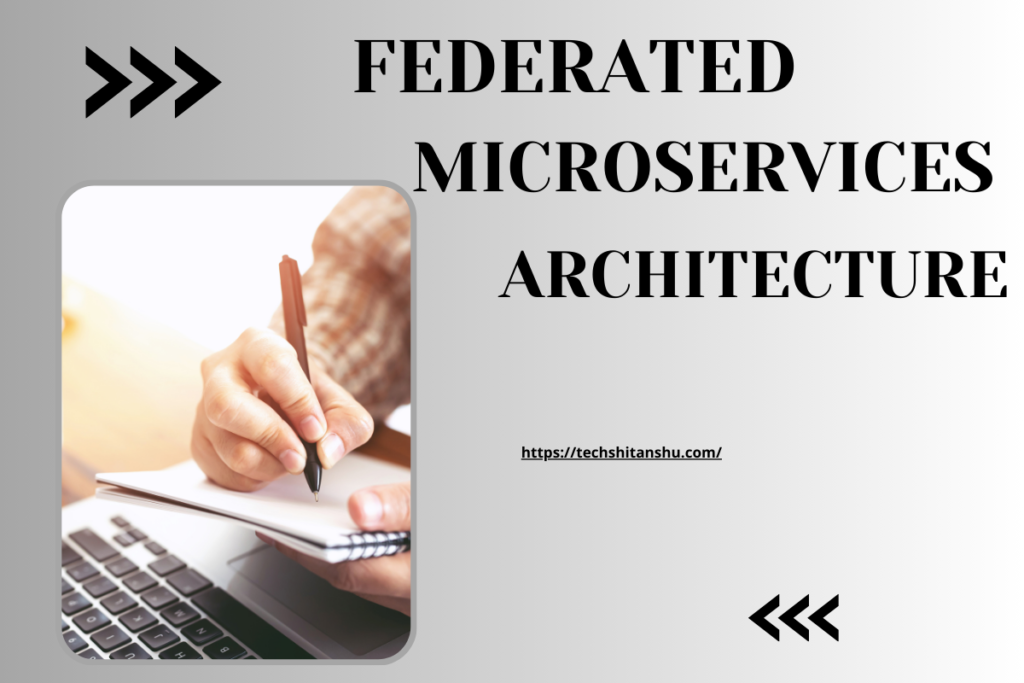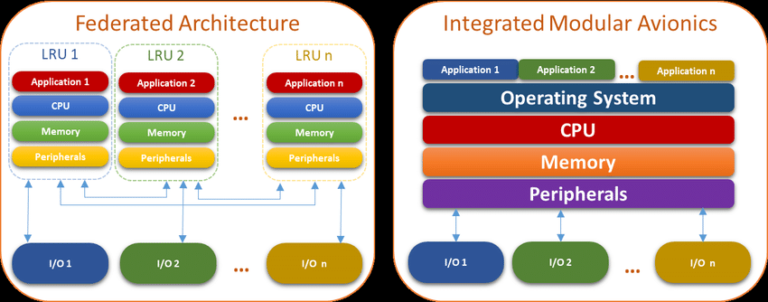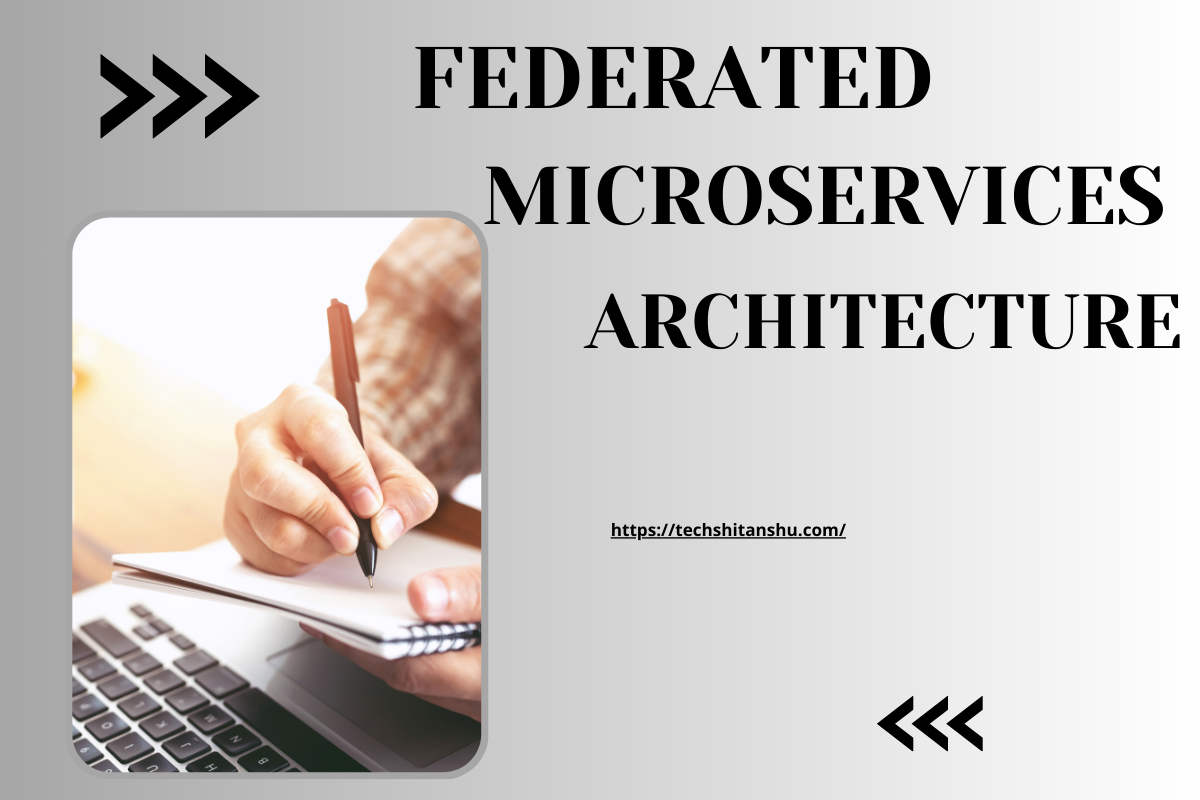Federated Microservice Architecture
Federated Microservice architecture is a strategic blueprint for IT systems that fosters coordinated management and seamless interoperability of data, resources, and processes across diverse systems, locations, and organizational boundaries.
Imagine it as a shift away from the traditional monolithic approach towards a decentralized model, creating a web of interconnected entities be it systems, applications, or databases each maintaining its autonomy while collaborating effectively.

Now, let’s delve into the four key characteristics that define federated microservice architecture:
Decentralization: In this setup, every component holds its ground, operating independently and making decisions autonomously. This autonomy is essential, empowering units to respond swiftly and flexibly to changing circumstances.
Interoperability: Federated microservice architecture is engineered to seamlessly interact with a variety of systems, regardless of their underlying technologies, protocols, or standards. This capability ensures smooth communication and data exchange across diverse platforms.
Scalability: As organizational demands evolve, federated microservice architecture offers a scalable framework. New systems can be seamlessly integrated into the federation, expanding its capabilities without disrupting existing operations.
Standardization: While each unit enjoys autonomy, there’s a common understanding of standards for interaction. Agreed-upon protocols ensure consistent communication and data sharing among systems, fostering cohesion within the federation.
In essence, federated microservice architecture empowers organizations to collaborate and pool resources while maintaining local control—a strategic approach to navigating the complexities of modern IT landscapes.
In the realm of database design, federated microservice architecture emerges as a crucial framework for navigating complex, distributed data systems. In today’s interconnected global ecosystems, this approach forms the foundation for seamlessly integrating and maintaining the independence of diverse data sources.
From the early days of straightforward, single-database systems to the intricate networks of the present, the escalating demands of international businesses and the exponential surge in data volume and diversity have propelled the evolution of database design.
Initially, centralized databases sufficed for managing organizational data. However, as data grew more crucial to business operations, the necessity for a distributed database management approach became evident. This necessity led to the advent of federated architecture—a system enabling the integration and independence of multiple, geographically dispersed data sources.
In our contemporary landscape, federated microservice architecture is a favoured framework due to its efficiency and flexibility in data management. It addresses the shortcomings of traditional database systems by enabling organizations to link and oversee diverse datasets without centralization.
Federated architecture not only facilitates seamless data integration across various platforms and systems but also upholds the autonomy of each participating database, ensuring that data remains secure, pertinent, and controllable.
Transforming complexity into strategic advantage
Operating within a federated data ecosystem or considering a transition to one presents an opportune moment to maximize the value derived from your data.
Within this landscape, many Platform assumes a crucial role. This platform seamlessly integrates with diverse data environments, leveraging the inherent complexities of federated systems to drive strategic business advantages. By enhancing data sharing and collaboration, they not only streamlines operations but also establishes a single system of record for data, optimizing overall business efficiency.
Moreover, equips organizations with robust policy management capabilities to uphold governance standards and enforce regulatory compliance. This unified approach offers a comprehensive view of data quality and compliance across all systems, which is particularly vital for organizations navigating complex data landscapes. By facilitating effective data management and interoperability, empowers organizations to successfully navigate the intricate web of federated systems, thereby ensuring data integrity and reliability.
Let’s ponder this: what similarities exist between software architecture patterns and food trucks?
Well, they both boast a rich assortment of options, each with its own unique flavors and styles. Some dishes or patterns garner rave reviews, while others might leave a bad taste in your mouth. And much like foodies debating the best cuisine, tech experts and enthusiasts can passionately argue for hours over the merits of different architectural approaches. It’s the little details that can either elevate the experience or lead to disappointment.
Consider this scenario: you place an order at a food truck. Will you get exactly what you asked for, or will there be a mix-up? Is the process smooth, or do you have to jump through hoops to get your meal just right? And what happens when the popularity of your favorite food truck skyrockets, and suddenly there’s a line around the block?
As time ticks by and your hunger grows, you might opt to seek sustenance elsewhere.
We have certain expectations from the services we use. We want our orders to be accurate and complete—no need for follow-up requests. And we demand speed; we shouldn’t have to wait or look elsewhere for a similar product.
With these expectations in mind, let’s explore how federated microservice architecture comes into play and how it can enhance the application development process.
What exactly is federation?
Federated microservice architecture, or federation, is a design pattern we can employ when constructing our applications. It pairs seamlessly with GraphQL, allowing us to focus on the core elements that matter most to end-users, all without sacrificing development speed.
In a federated microservice architecture, different autonomous services form the backbone of the system. These services act like specialized functions or business units, each with its own distinct focus. This autonomy empowers each service to determine the type of data and processes it handles, as well as its contribution to the larger system.
Each service contributes its GraphQL schema—a comprehensive blueprint detailing its capabilities, data requirements, and response formats. The magic of federated microservice architecture emerges when these individual pieces, spanning across various services, seamlessly integrate into a unified GraphQL API.
Here’s where the “federated” aspect shines: each service operates independently within its domain while contributing to the collective whole, ensuring smooth and efficient system operation. This approach also simplifies the querying process, allowing us to seamlessly access data from different domains without worrying about piecing together disparate responses.
Let’s revisit our food truck analogy to illustrate this concept. (We’re venturing into the world of snacks-as-a-service now!) 🍕
Imagine you’re ordering snacks from multiple food trucks. Several factors contribute to a seamless ordering experience:
-
Menu Availability: You want to know which dishes each food truck offers and whether your desired items are in stock.
-
Smooth Checkout: A streamlined payment process ensures that discounts are applied correctly, items are accounted for, and there are no duplicate charges.
-
Customer Engagement: Providing your contact information might unlock perks like loyalty rewards, punch cards, or special discounts tailored to your preferences.
Zooming out, we can identify three key domains: dishes, orders, and customers. Each domain warrants dedicated attention and resources, and it’s through their harmonious synchronization that transactions are made, orders are fulfilled, and customer satisfaction is achieved.
So, what would our “food truck” system look like in a single graph? As a customer, imagine crafting a query that retrieves data from all relevant services—a comprehensive request that captures everything you need in one fell swoop. Something like:
And what about from the perspective of the organizers? Think of the food truck managers, the event sponsors, and the backend business folks—they all have burning questions about sales performance and areas for improvement. Can they piece together various data points from each service with just one big query?
Let’s break it down:
Top Sellers and Meal Combinations: They might want to know the three most popular items from each food truck over the last month and which meal combinations flew off the shelves. This involves pulling data from the orders and dishes services.
Average Order Value and Wait Time: They could be interested in the average dollar amount of orders between October and June, along with how long customers typically wait before placing another order. This requires data from the orders and customers services.
Despite combining all these inquiries into one query, each component relates to a specific service. The beauty of a federated graph is that we don’t need to worry about which piece goes where when requesting data. The central graph handles everything, looking up each field in the schema and routing it to the responsible service.
So, while the orders service fetches data on order volume and spending habits, the dishes service gathers menu details, and the customers service retrieves information on order frequency. Despite each service managing its domain, they seamlessly collaborate to provide a comprehensive picture.
The Federated Microservice API Gateway:
This centralized gateway acts as a one-stop-shop for all requests, dividing them among backend services for processing. Each service retains control over its data and requirements, providing flexibility for the team managing it while fitting into the larger system puzzle. Through this coordination, robust requests are executed with consistency and speed.
Consistency for Consumers and Maintainers:
When querying the gateway, whether for data retrieval or modification, the process remains consistent. Clients don’t need to worry about correct methods or endpoints—the GraphQL schema dictates everything needed to craft queries accurately. This ensures that all frontend applications consume data consistently, without surprises.
For backend maintainers, this setup offers flexibility. Decoupled services can be swapped in and out as needed without disrupting other services. A self-documenting schema eliminates the need for extensive documentation before users can build requests and clearly communicates any changes or deprecations.
Federating the Monolith:
In contrast, a monolithic architecture presents agility challenges. With all focuses built into one codebase, overlap between domains occurs, hindering clarity and coordination. Iterating rapidly becomes challenging, as even minor changes can ripple through the entire system.
Using REST in a monolith introduces dozens, sometimes hundreds, of endpoints, each with its nuances. This can prove cumbersome for downstream consumers, leading to increased latency and complexity in assembling data.
In essence, more requests to more endpoints tailored to specific requirements translate to longer assembly times. A monolithic approach struggles to excel in any one area, leading to delays and inefficiencies.
The Road to Improvement:
The good news is that federation principles can be applied to even the most complex monolithic architectures. GraphQL and federation allow for incremental adoption, offering relief to unwieldy systems.
Interested in learning more? Dive into Odyssey’s course on federating existing monoliths to discover how to ease system pressure and enhance performance.
8 Essential examples of federated architecture
Federated microservice architecture is especially useful in complex environments where complete integration is not feasible, practical, or desirable. Here are some detailed examples for federated architecture:
- Multi-departmental organizations
- Mergers and acquisitions
- Healthcare networks
- Research collaborations
- Supply chain management
- Cloud services integration
- Government services
- Financial services

The Federated microservice Architecture (FMA) model, with its focus on autonomy through shared models, necessitates the establishment of a foundation known as the Federated Architecture Foundation (FAF), akin to a set of guiding principles or a “corpus juris” like The Ten Commandments. In the absence of a global authority, federated architecture faces a challenge: balancing the autonomy of components with the need for effective information sharing (Heimbiger, 1985). This challenge underscores the critical importance of governance within federated architecture.
The FAF serves as the legislative body within this framework, requiring an executive or architecture enforcement quality control (QC) process, and at times, a jurisdictional oversight. This governance structure ensures that the autonomy of individual components is respected while facilitating the necessary level of information exchange and collaboration essential for the functioning of the federated system.
Federated microservice architecture compelling advantages
Federated microservice architecture offers several compelling advantages that address key challenges and requirements in modern software development and system design:
Scalability: Microservices, by nature, allow applications to scale more effectively by breaking down functionality into small, independent services. Federated architecture extends this scalability by enabling services to be distributed across multiple teams, departments, or even organizations. This decentralized approach allows for efficient scaling of both development efforts and system resources.
Autonomy: In a federated microservice architecture, each microservice operates independently and can be managed by different teams or entities. This autonomy fosters innovation and agility, as teams can make autonomous decisions about their services without being overly dependent on centralized control.
Resilience: Federated architectures enhance system resilience by distributing services across different environments or locations. This helps minimize the impact of failures or disruptions in one part of the system, as other services can continue to operate independently.
Interoperability: Federated microservices can facilitate interoperability between different systems or organizations. By defining clear interfaces and communication protocols, services can interact seamlessly across boundaries, enabling cross-domain collaborations and integrations.
Data Sovereignty and Compliance: In scenarios where data sovereignty and regulatory compliance are critical, federated architectures provide a framework for managing data within specific jurisdictions or organizational boundaries. This can be particularly important in industries such as healthcare, finance, or government.
Ecosystem Flexibility: Federated microservice architectures are well-suited for ecosystems that involve multiple stakeholders, partners, or vendors. They enable the composition of services from various sources, fostering an ecosystem of interoperable and reusable components.
Reduced Coupling and Dependency: By decoupling services and teams, federated architectures reduce tight coupling and dependencies between components. This leads to greater flexibility in system evolution and maintenance, as changes to one service have minimal impact on others.
Overall, federated microservice architectures provide a robust framework for building scalable, resilient, and interoperable systems in diverse and complex environments. They empower organizations to leverage distributed resources effectively while maintaining autonomy and flexibility across interconnected services.


Leave a Reply